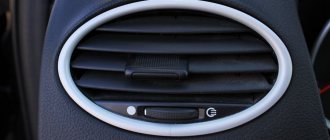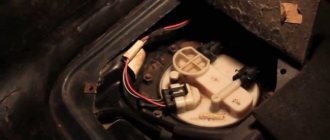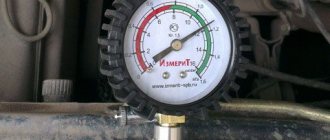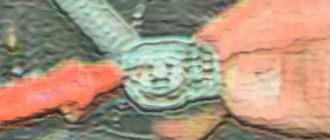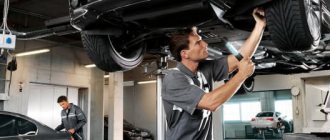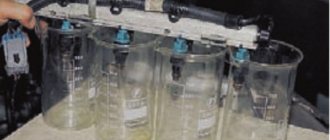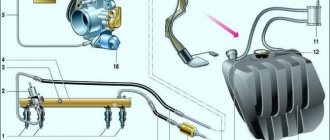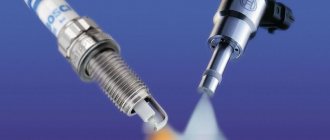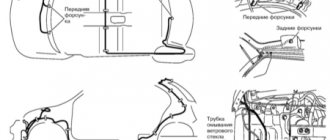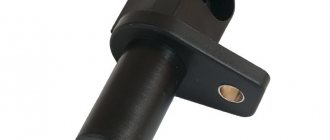A car's fuel system loses its functionality over time. The occurrence of contamination leads to a change in the operating mode of the engine. Loss of power and exhaust smoke are only a small part of the problems that arise. To correct this situation, you will need to replace the injectors or service them. The use of special additives can help prevent contamination, but is not a panacea. Figuring out how to change a clogged injector is quite simple; you only need to partially disassemble the fuel system.
Purpose and causes of injector failure
The injector ensures the injection of a precisely measured portion of fuel into the internal combustion chamber. Any deviation from the calculated indicators affects the movement of the car. During operation, replacement of fuel injectors is almost inevitable. To ensure optimal performance of the internal combustion engine, it is necessary that the tightening of the injector after its replacement be accurately maintained. The high cost of such repairs in a service center makes such a task as installing injectors quite relevant.
Among all the elements of the car, the injector is the most susceptible to contamination. Exposure to high temperatures and insufficient fuel quality leads to the appearance of a coating that has the structure of a varnish. Such a blockage changes the precisely calculated characteristics of fuel injection, which negatively affects the operation of the engine. To understand how to remove injectors, you should study the structure of the car. The diesel engine has a more complex injector installation system and you will need to accurately remember the entire disassembly sequence.
Contamination of the nozzle reduces its throughput, and even installing filters does little to solve such problems. Any fuel contains heavy particles, and stopping the engine leads to even more of them due to the lack of cooling of the injector. As a result, light fuel particles evaporate, and heavier ones settle in the form of varnish-like deposits. Such clogging affects the preparation of the combustible mixture, which affects the performance of the fuel pump and the engine as a whole.
Checking diesel injectors for overflow (drain to return)
As diesel injectors wear out over time, a problem arises due to the fact that the fuel from them gets back into the system, due to which the pump cannot generate the required operating pressure. The consequence of this may be problems with starting and operating the diesel engine.
Before the test, you will need to buy a 20 ml medical syringe and an IV system (to connect the syringe you will need a 45 cm long tube). To find an injector that throws more fuel into the return line than it should, you need to use the following algorithm:
- remove the plunger from the syringe;
- with the engine running, use the system to connect the syringe to the “return” of the injector (insert the tube into the neck of the syringe);
- hold the syringe for two minutes so that fuel is drawn into it (provided that it will be filled);
- repeat the procedure one by one for all nozzles or build a system for all of them at once.
Based on information about the amount of fuel in the syringe, the following conclusions can be drawn:
Checking the return flow
- if the syringe is empty, it means the nozzle is fully operational;
- the amount of fuel in a syringe with a volume of 2 to 4 ml is also within normal limits;
- if the volume of fuel in the syringe exceeds 10.15 ml, this means that the injector is partially or completely out of order and needs to be replaced/repaired (if it pours 20 ml, then it is useless to repair, since this indicates wear of the injector valve seat ), since it does not maintain fuel pressure.
However, such a simple check without a hydraulic stand and plan test does not give a complete picture. Indeed, in fact, when the engine is running, the amount of fuel discharged depends on many factors; it can be clogged and needs to be cleaned, or it freezes and needs to be repaired or replaced. Therefore, this method of checking diesel injectors at home allows you to only judge their throughput capabilities. Ideally, the amount of fuel volume they pass through should be the same and range up to 4 ml in 2 minutes.
You can find the exact amount of fuel that can be supplied to the return line in the manual of your car or engine.
To ensure that the injectors last as long as possible, refuel with high-quality diesel fuel. After all, it directly depends on the operation of the entire system. In addition, install original fuel filters and do not forget to change them on time.
Signs of injector failure
The operating life of the injector is at least 100 thousand km, but low-quality fuel and untimely maintenance of fuel filters can significantly reduce this period. A clogged injector will require its calibration or replacement, and the main symptoms of malfunctions are as follows:
- Unstable engine operation;
- Loss of power and poor acceleration dynamics;
- Difficulty starting the power plant;
- Stopping the engine at idle speed;
- The appearance of sharp sounds when starting the engine;
- Increased CO content in exhaust gases;
- Malfunction of the oxygen level sensor;
- Increased fuel consumption.
Before disassembling, you can try to determine the injector malfunction. This technique will make it easier to remove the injectors from the engine, and only the non-functional part will need to be removed. Carrying out such testing is effective and not difficult. Each injector is turned off in turn and the absence of engine smoke or other signs will unmistakably indicate a non-working injector. Before dismantling, all injector wiring must be disconnected and the pressure in the fuel system must be relieved.
What to do if she gets stuck?
To prevent such a nuisance from occurring, it is necessary to monitor the condition of the engine and its parts, dismantling the injectors every 50,000 kilometers. Lubricate them with non-stick paste before installation and clean their threads. However, if such prevention does not help, and they still become attached, then you need to immediately contact qualified specialists, that is, us.
We provide fast and high-quality removal of diesel injectors. For many organizations, a serious problem is the removal of 4 and 5 injectors from cars such as SSang Yong Cayron, Rexton, Action, but we remove them even without the need to remove the cylinder head and hood.
Such broad capabilities of our organization are associated with qualified personnel and the latest functional technical base that we possess. By contacting us, you can remove the fuel injectors while guaranteeing the integrity of the cylinder block. Moreover, thanks to innovative approaches, after their dismantling, there is a high probability of restoring these parts.
Preparing to replace injectors
The process of dismantling the injector requires a tool, regardless of the location of the injectors in the vehicle's fuel system. Disassembly differs depending on the vehicle model and the type of fuel injection. In most cases, to replace injectors you will need the following tool:
- Ratchet wrench and socket set;
- Power pliers and pliers;
- Set of keys and screwdrivers;
- Carbcleaner for cleaning the engine;
- Rags or rags.
A modern injector is a complex electromagnetic device that is usually installed on the fuel rail. There are other variations of the injection system, which requires studying the characteristics of the car. When performing such work, the wiring and injector tube need to be handled carefully to prevent damage. Removing the injector for the first time may require outside help, and when replacing it, it is necessary to write a new code into the control unit.
Removing and replacing injectors
A car's mileage of more than 100 thousand km requires diagnostics and maintenance of the injector. You can carry out the entire cycle of replacement work yourself or remove the injectors along with the ramp and transfer them to a service center for further diagnostics and washing. In any case, the main disassembly process is much cheaper to do yourself and such work will have the following order:
- Turning off the car's power is done by removing the negative terminal from the battery;
- Relieving pressure in the fuel system - the pressure regulator is usually located on the fuel rail and is a valve, pressing which will drain excess fuel, for which you will need to place a collection container;
- Disabling the connecting block will allow you to gain free access to the fuel system. This disconnection of the injector wiring is also necessary for dismantling the injectors and is carried out with care so as not to damage the clips;
- Disassembling the fuel line - you need to disconnect all the equipment to get to the fuel valve and use a screwdriver to move the clamp, which is located along the ramp. Such operations will help free up space where the injectors are located and carry out dismantling;
- Removing the intake manifold - you will need to unscrew the bolts, which is most conveniently done with a ratchet wrench. Then the manifold will need to be pulled out, which will provide access to the place where the injectors are installed. When removing the ramp, you should inspect it for obvious defects;
- Removing the injector - use a screwdriver to move the clamp and release the sealing rings on the injector being replaced. They should be pulled out extremely carefully, rocking them in the connector, so as not to damage the ramp body.
A diesel engine or direct injection power unit has a more complex fuel system. To carry out such maintenance work, special pullers may be needed. To understand how to install injectors in such a machine, minimal knowledge of direct injection technology is required. In this case, fuel from the injector enters directly into the engine, which complicates the maintenance process.
Checking diesel injectors for overflow (drain to return)
As diesel injectors wear out over time, a problem arises due to the fact that the fuel from them gets back into the system, due to which the pump cannot generate the required operating pressure. The consequence of this may be problems with starting and operating the diesel engine.
Before the test, you will need to buy a 20 ml medical syringe and an IV system (to connect the syringe you will need a 45 cm long tube). To find an injector that throws more fuel into the return line than it should, you need to use the following algorithm:
- remove the plunger from the syringe;
- with the engine running, use the system to connect the syringe to the “return” of the injector (insert the tube into the neck of the syringe);
- hold the syringe for two minutes so that fuel is drawn into it (provided that it will be filled);
- repeat the procedure one by one for all nozzles or build a system for all of them at once.
Based on information about the amount of fuel in the syringe, the following conclusions can be drawn:
Checking the return flow
- if the syringe is empty, it means the nozzle is fully operational;
- the amount of fuel in a syringe with a volume of 2 to 4 ml is also within normal limits;
- if the volume of fuel in the syringe exceeds 10.15 ml, this means that the injector is partially or completely out of order and needs to be replaced/repaired (if it pours 20 ml, then it is useless to repair, since this indicates wear of the injector valve seat ), since it does not maintain fuel pressure.
However, such a simple check without a hydraulic stand and plan test does not give a complete picture. Indeed, in fact, when the engine is running, the amount of fuel discharged depends on many factors; it can be clogged and needs to be cleaned, or it freezes and needs to be repaired or replaced. Therefore, this method of checking diesel injectors at home allows you to only judge their throughput capabilities. Ideally, the amount of fuel volume they pass through should be the same and range up to 4 ml in 2 minutes.
You can find the exact amount of fuel that can be supplied to the return line in the manual of your car or engine.
To ensure that the injectors last as long as possible, refuel with high-quality diesel fuel. After all, it directly depends on the operation of the entire system. In addition, install original fuel filters and do not forget to change them on time.
Diagnostics and replacement of the injector
Injectors have a huge service life, and in some cases, cleaning is enough. When replacing them with non-original ones, registration of the injectors will be required; such information is entered into the electronic control unit and is necessary for engine operation. It is also important to maintain the tightening torque of the injectors, which ranges from 40–90 Nm and depends on the specific model.
The operation of the injector, although it seems complicated, upon closer examination becomes clear to every car enthusiast. A modern injector ramp has its own maintenance features that cannot interfere with disassembly and replacement of parts.
If you have any questions, leave them in the comments below the article. We or our visitors will be happy to answer them
Sprayer repair
Buying an injector is not a cheap pleasure. Therefore, drivers often resort to complex diagnostics and further repair of diesel injectors. The sprayer must be repaired in the following cases:
- The needle is stuck in the body due to deformation.
- There is dirt in the nozzle.
Ultrasonic cleaning and lapping using paste are recommended as effective methods for repairing the atomizer.
The replacement algorithm is quite simple. However, any breakdown is much easier to prevent. To do this, it is recommended to use high-quality fuel and additives. These measures will avoid time and money costs.

